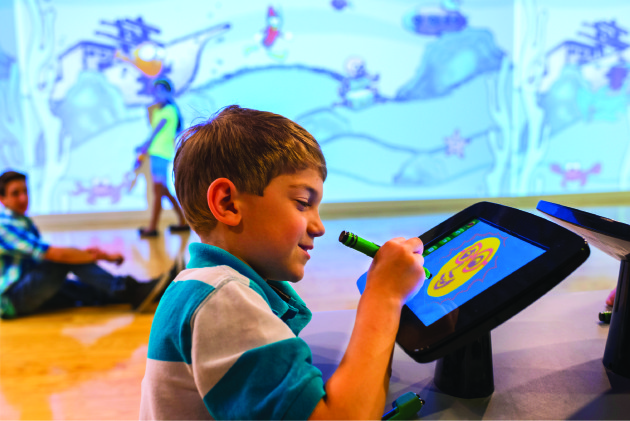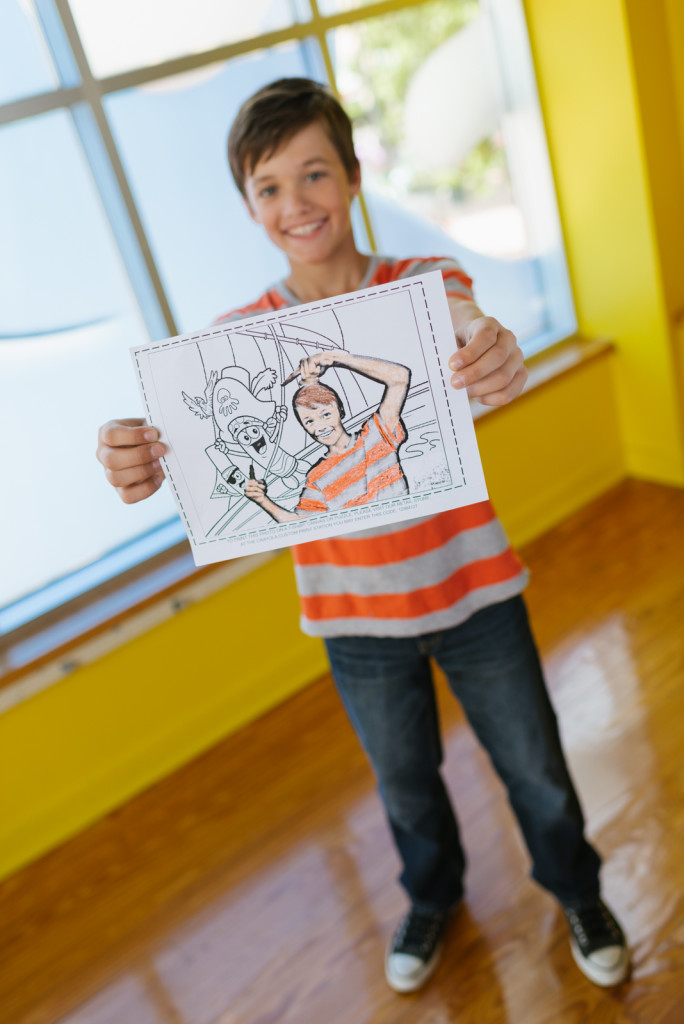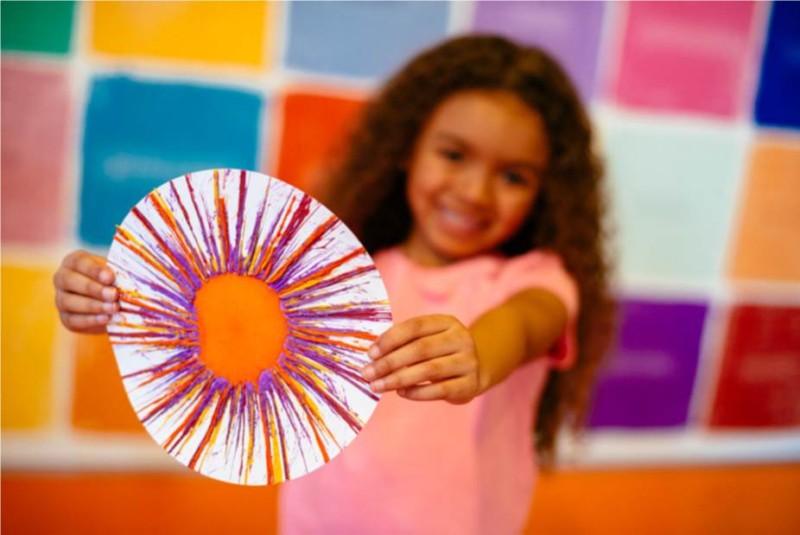New brand experiences color outside the lines – actively
by David Paul Green, Visual Terrain
The Crayola Experience is about experiencing creativity in bigger-than-life ways that you can’t really experience at home,” said Victoria “Vicky” Lozano, Crayola Senior Vice President and General Manager for Attractions & Retail. “It’s also about family experiences.” In other words, it’s not just about crayons, though the iconic Crayola crayon stands at the core.
The success of the first Crayola Experience, which — since its post-renovation re-opening in 2013 near the original Crayola Factory in Easton, Pennsylvania — draws some 400,000 visitors annually, encouraged the company to continue this form of brand extension by taking it into new markets. The Orlando Crayola Experience opened in July 2015, and Crayola is reportedly pleased with the results – so much so that the company has already announced a third location, at the Mall of America in Minneapolis.
What’s unique about the Crayola Experience? Lozano said, “Parents are doing things with their kids. Parents will do their own projects or they’re actively involved helping their kids. It’s a dynamic you don’t see in a lot of places.” There’s a lot to see and do, and Lozano said, “When people come to Crayola Experience, they’re staying 3 or 4 hours.” And they’re motivated to return more than once. “A lot of attractions, people go once a year or once in a lifetime. We offer an opportunity for people to come back time after time. It’s different every time you return.”
George Wade, president of Bay Laurel Advisors, contracted to Crayola as owner’s rep and project manager for Crayola Experience, said, “What makes the Crayola brand unique is the fact that it is a cherished brand across demographics, young and adult. It is a most trusted brand for mothers.”
The experiential design firm, Weber Group, worked with Crayola to develop the overall creative vision for Crayola Experience Orlando. Adam McIntyre, creative director on the project for Weber Group, said, “Crayola has been around for a long time and is instantly recognizable around the world. The whole team felt a deep responsibility being part of that heritage and a personal responsibility as we began to shape part of its future.” Weber Group’s key personnel for the project were Donny Weber, company owner and VP, who leads Weber from the design and architectural side, McIntyre, project designer Melissa Leahy and project manager Richard Antczak.
From Easton to Orlando
Crayola Experience Orlando has been positioned to differentiate from theme parks in a city best known for its theme parks. “Our competition is not theme parks – for three primary reasons,” Wade said. “First, their price point is very different. The Crayola Experience ticket price is $21.99; the annual pass is only $34.99 and guests can opt to apply the cost of a one-day ticket to an annual pass. Second, Crayola Experience provides for an average three-hour length of stay. Third, Crayola Experience is about hands-on, open-ended experience. Crayola sees creativity as an engaging, participatory process, versus something that is passive in nature, and the Crayola Experience brings interactive participation to life through its 25 different attractions.”
One of the key distinctions of the Crayola Experience in Orlando is its orientation to the resident market. “Since the Crayola Experience is a highly repeatable attraction, Crayola’s primary target is the local resident in the Metro Orlando marketplace,” said Wade. ”It appeals to tourists as well, but the core business principle begins with enhancing the emotional relationships with families within Orlando.” Wade reports that in just the first three months of operation, Crayola Experience was quickly adopted as a favorite in Orlando by local summer camps and families. “They’re looking for something unique, that is fun and educational at the same time,” he said.
When the opportunity at the Florida Mall presented itself, “Crayola realized this is a different product than what was already in the market, and wasn’t afraid of going head-to-head against the existing themed attractions,” said Wade. “Convincing guests to visit is always going to be something that has to be done, no matter what market you go into.” Maintaining and deepening the relationship between brand and consumer was key. “Crayola knew they needed to move this product into its next generation of life, and to do it in a very intelligent and cautious manner. Crayola is owner-operator of the Experience, and the trust the company has from consumers is a trust they take very seriously.”
Wade was first brought in to help make the transition that resulted in the first Crayola Experience. His own experience spans three decades working on themed entertainment and special venue projects ranging from large-scale theme parks to independent attractions, from the pre-development side as well as the design and execution side. Like many attractions industry professionals, his background is in theatre.
Crayola leveraged its experience with the Easton site into the Orlando project. “There were a tremendous amount of lessons we learned from Easton,” Wade said. “From operations, market research with our guests… We learned from our guests. We will always do that.”
Inside the team and the project
As with the first Experience, Crayola’s team was able to open the new project in a relatively short time. “It takes a village, and this took a village, especially under such time constraints,” Wade said. “We did this project in 11-and-a-half months!” He praised the team that was able to turn the project around so quickly, which included Crayola’s Facility Engineering department; the architectural and construction division at Hallmark; the Building Construction division at Simon Properties, and General Contractor J. Raymond Construction Corp.
Daniel Aylward, of Worldwide Leisure Management, who was part of the Crayola Experience team as a consultant, became COO of Crayola Attractions as a full-timer in November 2013. “Dan is a true, long-term expert in our industry,” Wade said. “Retaining a world-class operations executive was a critical part of Crayola’s commitment to truly running a first-class attraction for their guests.”
In addition to the above-mentioned companies and individuals and Weber Group, the team included (alphabetically listed) 37 Volts Lighting Design, retail lighting designer; Callison – Los Angeles, project architect; Geograph Industries for fabrication of the retail storefront and retail fixtures; IRES, real estate adviser; Magnetic Dreams, animation development; Management Resources, operations consultant; RAW Media Teknologies, audio video design and implementation; Reztark Design as project retail designers and architect of record; and Visual Terrain, attraction lighting design.
Key vendors included 1220 Exhibits for sets; CES (Creative Engineering Solutions) for interactive mechanical experiences; and software providers Little Orbit, Daqri and Zugara. ECA (Entertainment+Culture Advisors) did the initial market analysis that laid the foundation for Crayola’s search for a second location outside of Easton.
Weber Group’s McIntyre said, “Inspiration in this case for the project was simply the product itself. Encouraging parent participation and involvement in the attractions was a key goal for Crayola and at the forefront of how we approached each unique experience. In addition to their design role, Weber Group produced some of the branded themed elements, such as the large Tip characters (big crayon guys) that enliven the exterior approach.
Lighting played a significant part in the creative approach to the attraction. Visual Terrain principal designer Mike Mahlum said, “We had several creative influences, the Crayola brand being the primary driving element. It’s what drove our fixture choices, and the lighting patterns we selected with them.” For example: “For ‘Doodle in the Dark,’ which allows guests to create their own glowing designs on backlit doodle boards, we chose to use templates that look like scribbles and overlay them across the entire floor in this area,” said Mahlum. “This helped to give the guest a feeling of comfort, as there was now illumination in the space, but it allowed us to keep any spill off the walls where the experience component was located. The scribble pattern helped to reinforce what the area is used for. With the bright colors in the floors, we did not need any bright colors in the lights. It made the space become fully immersive.”
The 25 hands-on attractions in Crayola Experience Orlando also include “Art Alive!” where guests can project their own digital art on the wall. In “Wrap it Up!” they can personalize and print a Crayola crayon label and wrap it around their crayon to create a custom, unique souvenir. “Be A Star” uses green-screen technology to let guests become part of their own personalized coloring page, starring with whimsical crayon characters, which they may then print on paper, color, and take home. (Or print on a T-shirt, canvas or puzzle.)
There are also party rooms, so kids can share the experience with their friends, and a retail store, so they can take home what they need to keep creating memories after they leave. In homage to the original Crayola Factory in Easton, Pennsylvania, a “Crayon Factory” attraction shows guests how crayons are made, featuring whimsical Crayola characters and a live resident “Crayonologist” in a live theatre show.
Because it’s Crayola
The Crayola Experience colors outside the lines, making an attraction out of creativity itself. The corporation has not trusted simply to the power of its brand, but has sought the best possible way to leverage its dedication to creative inspiration while taking on the challenge to give the brand a new dimension.
Lozano is already predicting good things for the third Crayola Experience. “Because it’s Crayola, guests know it’s going to be fun, creative, and safe,” she said. “We start with the basis of a lot of good things, that they already know because it’s Crayola. It’s a hands-on attraction: 25 hands-on creative attractions and experiences. It’s an attraction that is not a passive, ‘watch me’ sort of setup. Guests realize, ‘I get to go and I get to have lots of fun, and do creative things. It’s a good experience for my family. Sign me up!’”
Crayola is a brand that brings back fond memories of childhood. Whether it is a piece of art hanging on the refrigerator door, the unique smell of a fresh box of crayons, or one’s first memories of creating something from scratch – out of nothing but imagination and drive – many adults can’t help but reminisce about their first contact with a simple, colorful, powerful crayon. • • •
 David Green is president and CFO of Visual Terrain, which is celebrating 20+ years of lighting design for architecture, attractions and the arts. He is the co-author with Steve Alcorn of “Building a Better Mouse: The Story of the Electronic Imagineers Who Designed Epcot,” which was based on their real-life experience at WED Enterprises in the early 1980s.
David Green is president and CFO of Visual Terrain, which is celebrating 20+ years of lighting design for architecture, attractions and the arts. He is the co-author with Steve Alcorn of “Building a Better Mouse: The Story of the Electronic Imagineers Who Designed Epcot,” which was based on their real-life experience at WED Enterprises in the early 1980s.
More InPark coverage of the first Crayola Experience can be found at https://www.inparkmagazine.com/photos-grandopening-of-the-crayola-experience/ and https://www.inparkmagazine.com/from-easton-to-orlando-crayola-redraws-the-brand-land-experience/.










